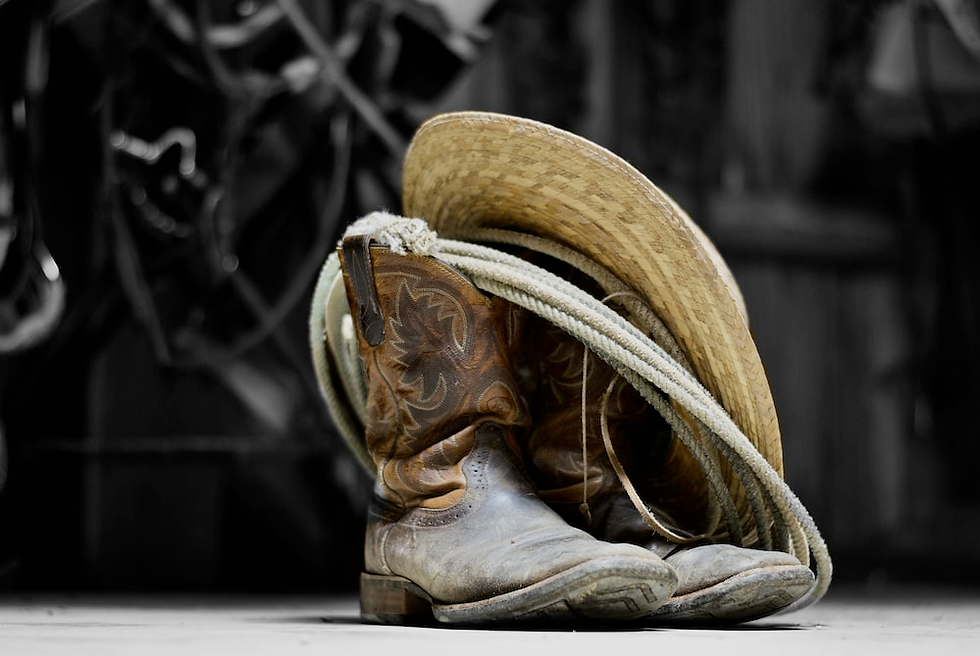The History and Process of Making Cowboy Boots
- New Cowboy Boots
- Aug 26, 2022
- 3 min read

Image Source: Unsplash
Few articles of clothing remain as iconic as the cowboy boot. Whether you think of Rip Wheeler and Beth Dutton in Yellowstone or just the general idea of being a cowboy, there is something about these tall boots that strike a chord with people. That’s because they are an article of clothing steeped in history and symbolism. They also happen to be extremely hard to make. Let’s take a look at the history and process of making cowboy boots.
The History of Cowboy Boots
As with many garments, the history of cowboy boots can be traced back to the Spanish. We know this because of the design of the spurs, which are similar to the ones used by Spanish horsemen of the 16th century. Spurred boots also appear in works of art created as early as the 15th century, including one painting by Leonardo da Vinci. There is also some evidence to suggest that the first cowboys may have worn moccasins. A pair of moccasins dating back to the 18th century has been discovered in Colorado. Another pair of moccasins dating back to the same time period was found in Texas. It is possible that moccasins were used because they were easier to make than spurred boots.
How Are Cowboy Boots Made?
Cowboy boots are made from scratch using a process that can take up to 45 hours per pair. The process starts with the selection of the right hide. Ideally, the hide should be from a cow that grazed on grass, not grain. This ensures the hide is soft enough to be turned into cowboy boots. The hide is then tanned, which means the skin is treated with chemicals to ensure it doesn’t rot. The next step is to cut out the shape of the boot from the hide. The process of cutting the hide is called “cutting the legs”. The cut is made from the center of the hide out toward the foot heel, which is where the toes will be. There are typically two pieces of leather for each boot, with the inside piece being called the “sole” and the outside piece being called the “upper”. The upper is typically stitched to the sole at the heel. The leather pieces are then “stitched out”, which means the pieces are stitched together. Once the pieces are stitched together, the boots are formed around a wooden last, which is a form the boots are molded around to give them their shape and size. The wooden last is sanded and polished, and the stitching between the upper and the sole is completed.
What Goes Into Making a Good Pair of Cowboy Boots?
Like we said, the process of making cowboy boots is long and arduous. If a particular step is rushed or done poorly, it can affect the end result. Let’s take a look at the factors that go into making a nice pair of cowboy boots. The Hide - As we mentioned before, the hide is crucial. A hide from a cow that grazed on grass is softer than one that grazed on grain, so it’s better for the making of cowboy boots. The Hide also needs to be thick. The thicker the hide, the longer the boot will last. The Sole - The sole of the boot is what the boot stands on. Ideally, it should be a dense rubber. This is because it’s the part of the boot that is going to wear down first. The sole also needs to be thick and be able to resist water and chemicals. A good cowboy boot sole should also be able to grip well. The Upper - The upper is what the boot is going to be seen from. It should be attractive, as well as durable. Ideally, the upper should be made from either stitched or pressed leather, though other materials are sometimes used.
Summary
The history of cowboy boots is long and storied, with roots in both the English and Spanish traditions. The making of cowboy boots is a painstaking process, with many steps that must be done correctly and thoroughly to ensure a good pair of boots comes out in the end. The hide, the sole, and the upper are all critical to making a good pair of boots.





Comments